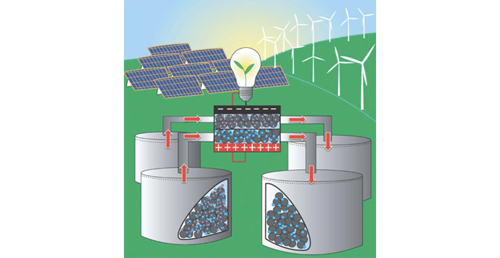Design of the next generation of slurry flow cells for electrical energy storage

We design new organic slurries for the charge storage in redox flow batteries. Those are made of conducting polymer or carbon conductor particles and other redox organic additives. We adapt the architecture of the redox flow cell to be appropriate to slurries and avoid obstruction phenomenon.
The global demand for electric energy is growing and cannot be stopped, which contributes to global warming. An increasing share of renewable energy sources can help curb CO2 emissions. However, wind flow and sunlight are intermittent, meaning power generation from windmills and solar panels is not always reliable. This obvious intermittency in renewable energy supply, along with fluctuations in demand, highlights the importance of stabilizing the electric power grid. It’s important to note that grid stability involves more than just providing sufficient electricity to consumers on average—it also includes various parameters that must be managed over timescales ranging from milliseconds to hours.
Electrochemical devices store and release electric energy: batteries operate more slowly, while supercapacitors can respond very quickly. Both can contribute to grid stabilization, provided they are scalable. Scalability can be achieved when energy storage in large external tanks is decoupled from the charge/discharge cells, whose dimensions are determined by the physics and chemistry of the processes involved. In such flow devices, active materials are pumped between the tanks and the cell.
An emerging idea is to use, instead of solutions, suspensions or thicker slurries of energy-carrying materials in water with necessary additives. In this project, we propose to study the storage and transfer of electric energy using such flowable slurries made from organic, sustainable, non-toxic, and inexpensive materials. Depending on their composition, the behavior of these slurries can be adjusted to resemble either battery-like or capacitor-like systems. The challenge is to turn this promising idea into a practical solution by addressing several fundamental and engineering problems. These include, on one hand, physico-chemical tasks related to preparing and characterizing stable flowable slurries capable of delivering relevant power and energy, and on the other hand, designing flow cells and circuits adapted to the properties of these slurries.
Involved in the project
Viktor Gueskine, Penghui Ding, Jaywant Phopase, Pawel Wójcik, Peter Ringstad, Reverant Crispin
Partners
Redoxme, LiU, Ligna Energy
Funders
Redoxme, Ligna Energy, LiU, Swedish Energy Agency